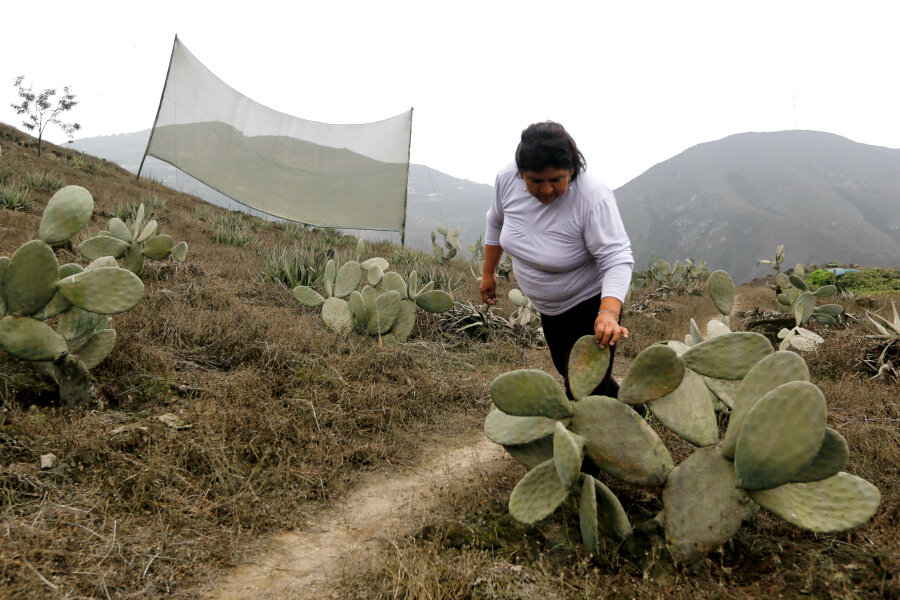Drip, drip, drip: Tanzania farmers learn to defeat drought
Loading...
| HAI, Tanzania
Peter Chuwa has long flooded his paddy field using a canal that draws water from the river. These days, however, water is scarcer and growing rice this way is proving hard to sustain.
A period of drought set in two years ago, and the abundant water that once helped suppress weeds in his fields and assure him of a crop regardless of rainfall has disappeared, hurting his harvests and his income.
"I was very frustrated because my crops were drying up before harvest,” he said. “It reached a point where I even struggled to feed my own family,” Mr. Chuwa says.
Now, however, a drip irrigation system, introduced to help his village deal with worsening drought, is restoring his harvests, building his resilience to erratic weather, and saving time, he says.
"You simply open the tap and leave the kit to supply water to the roots, unlike the traditional system, which takes a lot of time and energy,” he said.
Under pressure from drought, the 65-year-old farmer at Kikavu Chini village in Hai district in Tanzania’s northern Kilimanjaro region has switched to crops that need less water, including vegetables, maize, potatoes, and beans. A drip irrigation system, which uses far less water, supplies plenty to grow those crops, he says.
Under a five-year–project supported by Catholic Relief Services, a global development agency, farmers in Kikavu Chini village are being trained to use drip Irrigation and other water management techniques as a coping strategy for drought.
Chuwa is among 25 farmers who have now adopted the technology, which delivers only as much water as is needed, cutting water use by about 75 percent and reducing losses to evaporation.
Ilan Bar, a retired agronomist and US volunteer who works on the project,says most farmers who have adopted drip irrigation find it more effective and economical.
Nguluma Mbaga, a Kikavu Chini agricultural field officer, says the technology has come at the right time as farmers try to find ways to cope with worsening drought and other effects of climate change.
"I believe farmers will be in a better position to cope with the changing weather patterns. This village is located in a dry area that does not get adequate rains, so farmers must try to use water wisely,” he says.
Ufoo Adonikamu, the Catholic Relief Services program coordinator, says the agency, which is supported by the United States Agency for International Development (USAID), is working with other institutions and government agencies to try to roll out drip irrigation kits to farmers in other parts of the country.
Tanzania is currently implementing 39 irrigation schemes on a total of 16,710 hectares (about 65 square miles), using drip irrigation technology at a cost of Tsh. 677.5 billion (around $400 million), according to the Ministry of Agriculture, Food Security, and Cooperatives.
Local analysts say the country has huge potential for irrigation, since today its agriculture is almost entirely rain fed. But putting in place sustainable irrigation requires heavy investment, they said.
"You have to take into account a whole load of geographic, agronomic, and economic factors to make irrigation projects sustainable,” says Makarius Mdemu, a lecturer in natural resources management at Ardhi University in Dar es Salaam, Tanzania.
Tanzania’s parliament last year passed a national irrigation law aimed at protecting the country’s farmers from the vagaries of extreme weather and climate change, and to help farmers use irrigation to improve food security and reduce poverty.
The new law, which allows farmers to expand their operations onto government-controlled land if they use irrigation sustainably, also paves way for the formation of an Irrigation Development Fund to help irrigation schemes, many of whom are mired in financial woes.
Agriculture is the backbone of Tanzania’s economy. It accounts for more than one quarter of gross domestic product (GDP), provides 85 percent of exports, and employs about 80 percent of the workforce.
The country has 29.4 million hectares (114,000 square miles) of land that could be irrigated, out of which only 589,245 hectares are currently being irrigated, according to the Ministry of Agriculture, Food Security, and Cooperatives.





